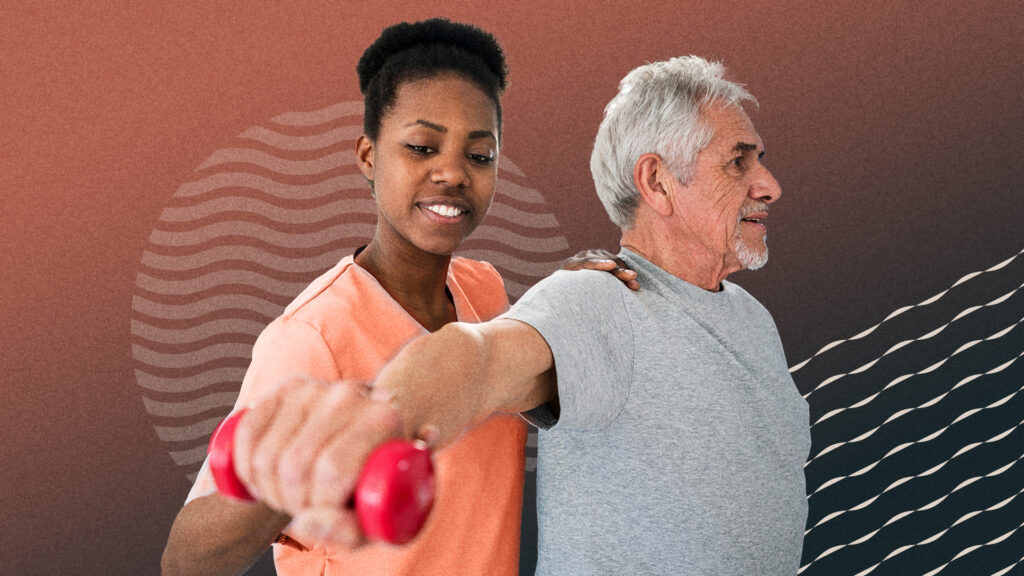
The State of Diversity in Physical Therapy
Physical therapists and physical therapist assistants treat patients in all corners of the country—from the small, quiet towns in middle America to the big, bustling coastal cities. But even though PTs treat a wide variety of patients in a wide range of places, there’s a huge disparity between the therapists who provide treatment and the patients who receive it. The physical therapy profession suffers from a serious lack of diversity, stymying industry growth and innovation and negatively affecting patient care.
What is diversity?
Though the word “diversity” itself simply means having variety, true diversity in a professional setting requires more than hiring a couple people who look different than you. It requires acknowledging when a workforce is homogenous—and understanding why that’s an issue. It also requires acknowledging that there’s inherent value in hiring employees who come from different racial, cultural, and social backgrounds and have had a wide array of life experiences.
But more importantly, a truly diverse environment not only accepts all sorts of people, it also celebrates and appreciates differences and functions off a premise of mutual respect. Some of these differences may manifest in a person’s “race, ethnicity, gender, sexual orientation, socio-economic status, age, physical abilities, religious beliefs, political beliefs, or other ideologies.”
Is the physical therapy profession diverse?
The short answer? No—especially when it comes to racial and ethnic representation, and that’s exactly what we at Rizing Tide are committed to improving. Let’s take a look at the numbers.
According to the Bureau of Labor Statistics, there were 281,000 employed physical therapists in the US in 2020. Here’s how the demographics shook out.
| White | Black or African American | Asian | Hispanic or Latino |
| 77.8% | 5.2% | 15% | 4.4% |
For comparison, take a look at the racial distribution in the US Census Bureau’s 2019 general population statistics.
| White, not Hispanic or Latino, Alone | Black or African American | Asian | Hispanic or Latino | Native Hawaiian and Other Pacific Islander | American Indian and Alaska Native | Two or More Races |
| 60.1% | 13.4% | 5.9% | 18.5% | 0.2% | 1.3% | 2.8% |
While these data pools aren’t perfect one-to-one comparisons, the numbers shouldn’t be this disparate. For instance, 39.9% of the United States population is Black, Indigenous, and/or a person of color (BIPOC)—and yet only 22.2% of employed physical therapists are BIPOC. The disparity is especially clear when we focus on the underrepresentation of Black or African American and Hispanic or Latino Americans in this data.
The APTA experiences this problem on an even bigger scale.
Not for lack of trying, the American Physical Therapy Association (APTA) has yet to close the gap between the demographics of the country and the demographics of its member base. The APTA has dedicated a lot of money and effort toward improving diversity in the PT profession, but the numbers speak for themselves. Take a look at this data from the 2020 workforce analysis created by the APTA itself:
| White, not Hispanic or Latino | Black or African American | Asian | Hispanic or Latino | American Indian | Other |
| 84.3% | 2.5% | 6.9% | 3.5% | 0.4% | 2.4% |
According to this data, only 15.7% of APTA Members are BIPOC—24% lower than the US census data. This gulf in the numbers suggests that the barriers non-white PTs face when seeking employment are magnified when it comes to joining their industry’s professional association. Or, even worse, BIPOC professionals don’t see value in—or feel welcomed by—their professional organization.
How does diversity improve healthcare?
As we like to say at Rizing Tide, we are better when we rise together. We firmly believe that embracing our differences and collaborating with people who don’t share our life experiences is the best way to grow ourselves, problem-solve, and improve the world we live in. That said, diversity in healthcare does also have some tangible benefits.
More diversity is a step toward equity.
As it stands, people in this country do not stand on equal footing, and too often your opportunities are dictated by the color of your skin. Poverty and poor health outcomes disproportionately affect communities of color, and non-white workers are significantly less likely to find employment in the upper echelons of the working world. (Seriously, take a peek at the racial distribution of some of the upper-level professions listed in this BLS report.)
Knowing that, if we begin to see more diversity in professions that have historically been homogenous and white, then we’re doing something right. We’re addressing the root of the systemic inequality that bars non-white people from pursuing the careers they want—especially in the medical field.
Cultural competence improves the patient experience.
Over time, the US has become more and more culturally complex, and providers often treat patients who have different cultural needs and expectations from their own. These patients thrive when their provider understands their needs right off the bat and can suggest treatment solutions or alternatives that suit them. Take this PT in Motion article, for example. Dr. Muhammad Alrwaily, PT, MS, PhD, discusses how a Muslim patient may want additional privacy or need an altered exercise plan during Ramadan.
While it’s totally feasible to provide excellent cross-cultural care, that ability has to be learned and developed over time—and it only helps when you’re accustomed to working with peers who have different backgrounds than your own.
When I was the clinic director of a large sports medicine clinic in Tempe, Arizona, we worked with a diverse population that included a high percentage of Hispanic and Latinx patients. Luckily, I spoke Spanish, but we deliberately hired an ATC and a PT tech with Hispanic roots to help us provide the best possible care for these patients. Our patient satisfaction scores were very high—and we received many physician and friend or family referrals specifically because we could accommodate patients’ specific needs. I have witnessed first-hand how cultural competence can make a difference in the patient experience.
Healthcare diversity can help address the social determinants of health.
As mentioned above, poor health outcomes disproportionately affect communities of color—due, in part, to the social determinants of health. Social determinants of health (SDOH), per the CDC, are “conditions in the places where people live, learn, work, and play that affect a wide range of health risks and outcomes.” Healthcare access, for instance, is a well-known SDOH, and it’s something that professional healthcare diversity can improve upon. According to this Health Affairs study, non-white providers are more likely to choose to work in a Health Professional Shortage Area (HPSA) “to a disproportionate extent.”
By bolstering diversity in the PT industry, we’ll organically increase the number of people who are willing to work in an HPSA, thereby addressing the inequities present in the SDOH.
Diversity is good for business.
We want to see PTs excel in their field—and studies have shown that companies with highly diverse teams are more likely to achieve better (and often above-average) financial performance. Diversity also drives innovation and improves workplace morale by making people feel more welcomed, accepted, and included.
Why is the PT profession not diverse?
There is no one specific cause to the PT profession’s diversity problem. Many social, economic, legislative, and historical factors have contributed to inequality—which in turn has reduced access to hard-to-reach places (like an expensive PT degree). Knowing that, we at Rizing Tide have pinpointed two potential reasons for this problem—and we’re trying to fight both of them.
The PT student pipeline is flawed.
A huge reason that clinic owners don’t hire a more diverse staff is simply because they can’t. The hiring pool is extremely limited because—perhaps unsurprisingly—the majority of students who enter a PT or DPT program are white. But don’t take my word for it. Check out this data collected by the Physical Therapist Centralized Application Service (PTCAS) during the 2018–2019 admission season.
| White, Not Hispanic | African American/Black, Not Hispanic | Asian | Hispanic or Latino | Hawaiian or Pacific Islander | American Indian/Alaskan Native | Two or More Races or Ethnicities | |
| PTCAS Applicants | 65.19% | 6.67% | 10.56% | 11.53% | 0.20% | 0.24% | 3.51% |
| US Census Data | 60.1% | 13.4% | 5.9% | 18.5% | 0.2% | 1.3% | 2.8% |
As you can see, Black and African American and Hispanic and Latino applicants are seriously underrepresented in the PT student population. But that’s not even the most interesting part of this data. As you can see here, PTCAS applicants are far more diverse than the current pool of employed therapists and APTA members. So, what happens between the time that students apply to a PT program and the time they apply for a job? Well, take a peek at this data, also collected by the Physical Therapist Centralized Application Service (PTCAS) during the 2018–2019 admission season.
| White, Not Hispanic | African American/ Black, Not Hispanic | Asian | Hispanic or Latino | Hawaiian or Pacific Islander | American Indian or Alaskan Native | Two or More Races or Ethnicities |
| 70.62% | 3.96% | 9.91% | 9.45% | 0.20% | 0.14% | 3.59% |
There is a huge disparity between the racial distribution of PTCAS applicants and accepted applicants. In fact, 14.2% fewer BIPOC PTCAS applicants are accepted into a PT program compared to their white counterparts. To be fair, these numbers have been improving since 2014, but we still have a long way to go before the student pipeline is equitable for all.
Implicit bias could play a role.
Everyone in the world has biases. Your unique life experiences have shaped how you view the world, and that in turn shapes your assumptions about, reactions to, and interactions with people, places, things, and events. Some of these biases are harmless; like preferring to buy blue clothing. But some of these biases can be extremely harmful to others—especially when it comes to an admissions or hiring process—because we don’t always recognize that they exist.
Take this case study from the Boston Symphony Orchestra. A huge majority of its musicians were men, though judges weren’t specifically trying to weed out women. So, in an effort to eliminate undetected biases, the orchestra started conducting anonymous auditions—even asking auditioners to take off their shoes so the judges couldn’t identify women by the click of their heels. Suddenly, the number of hired women shot up.
It’s possible that the PT industry’s implicit biases are rearing their heads—reducing the number of non-white PT students and new hires.
Which brings us to our final question.
How can we improve diversity in the PT field?
Unfortunately, there’s no easy, quick fix to this complicated, systemic problem. Believe me, if there was, we’d be working on it. That said, I know that we can chip away at the blockages in the PT pipeline by:
- Improving our outreach to non-white undergrad and high school students;
- Offering scholarships and providing mentorships to these students;
- Instating more BIPOC PT program faculty;
- Ensuring that implicit bias and cultural competency training is provided in PT schooling programs and clinics across the country.
That’s where Rizing Tide comes in. As part of our mission, we’re working to implement these exact solutions. We believe that this is the surest and quickest path to improving diversity, equity, and inclusion in the PT profession, and we are 100% dedicated to making that happen.
Want to help Rizing Tide make the world a better place for PTs and their patients? Sign up for our newsletter below to stay up-to-date with the latest news and info!


Thank you for your commitment to this work.
Of course. Please help spread the word to more PT students and residents.
TY!
Heidi